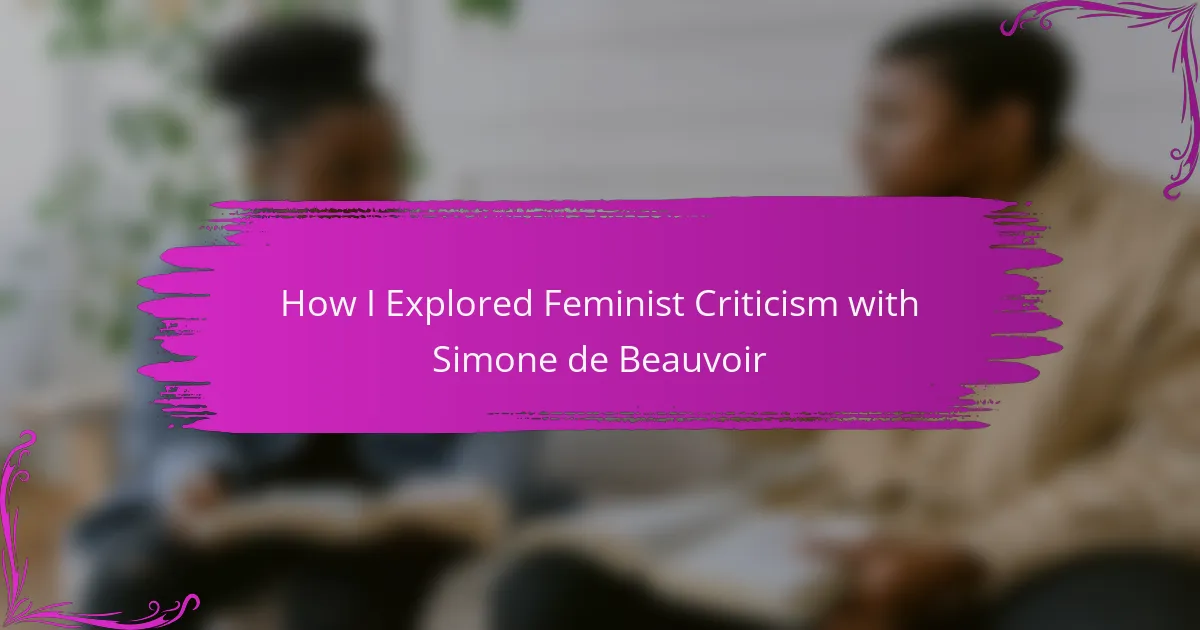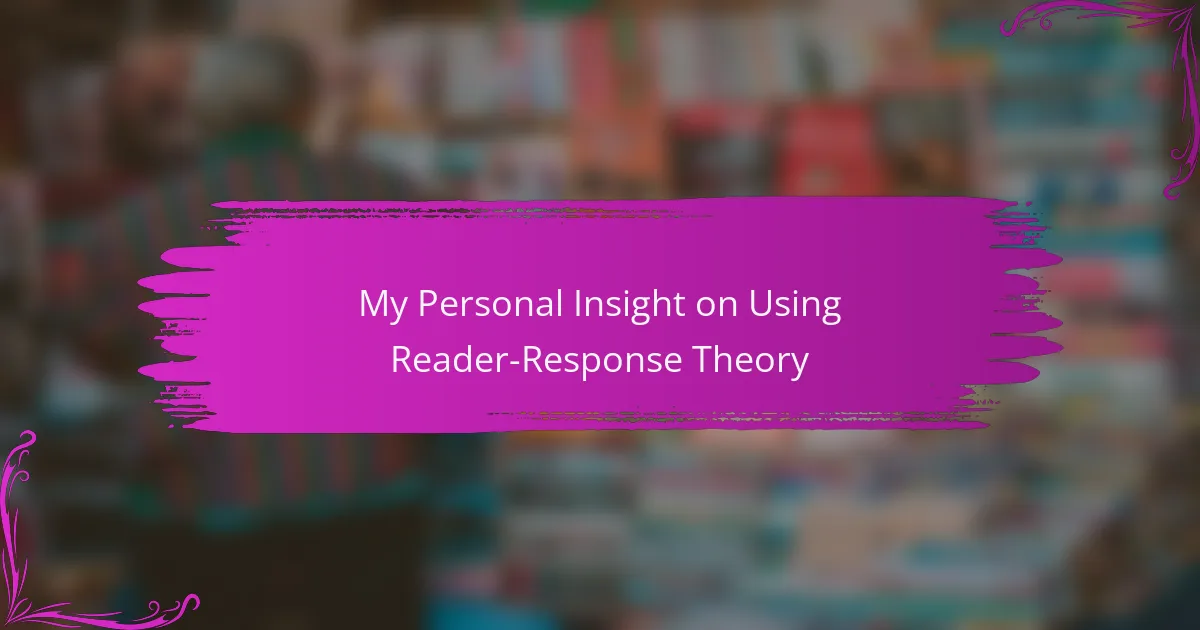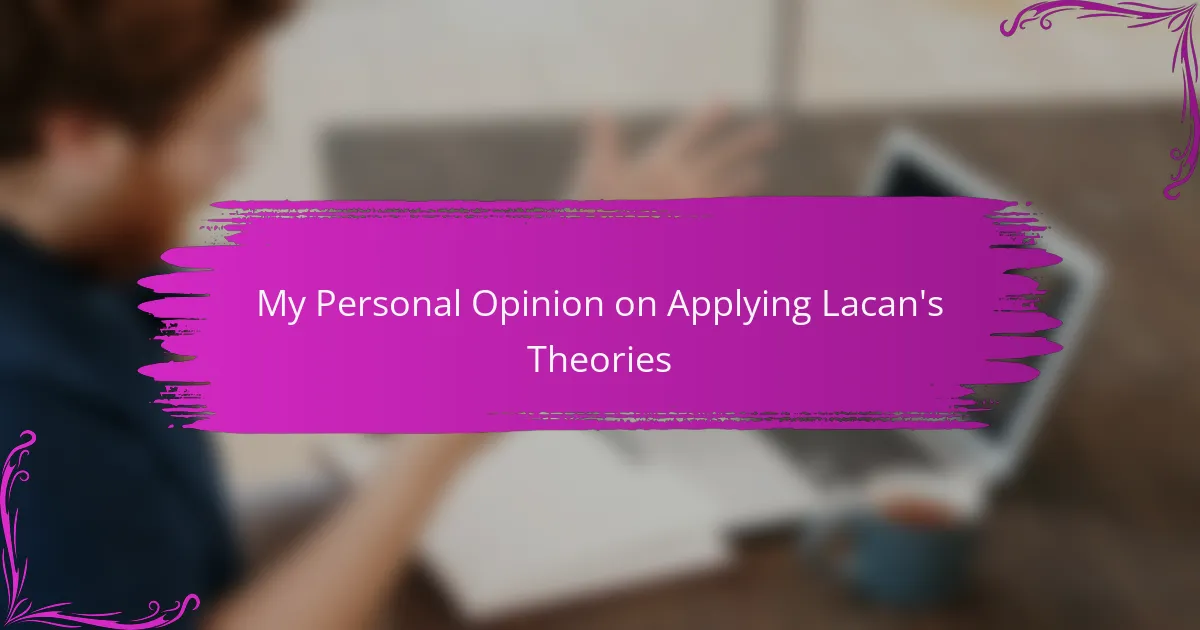Key takeaways
- Feminist criticism explores gender dynamics in literature, challenging traditional narratives and highlighting women’s experiences.
- Simone de Beauvoir’s “The Second [censured]” is a pivotal text that critiques women’s oppression and emphasizes the importance of freedom and choice.
- Key themes in de Beauvoir’s work include the concept of “the Other,” individual agency, and the quest for meaning within societal constraints.
- Practical applications of feminist criticism involve analyzing character development, questioning author perspectives, and recognizing recurring feminist themes in literature.
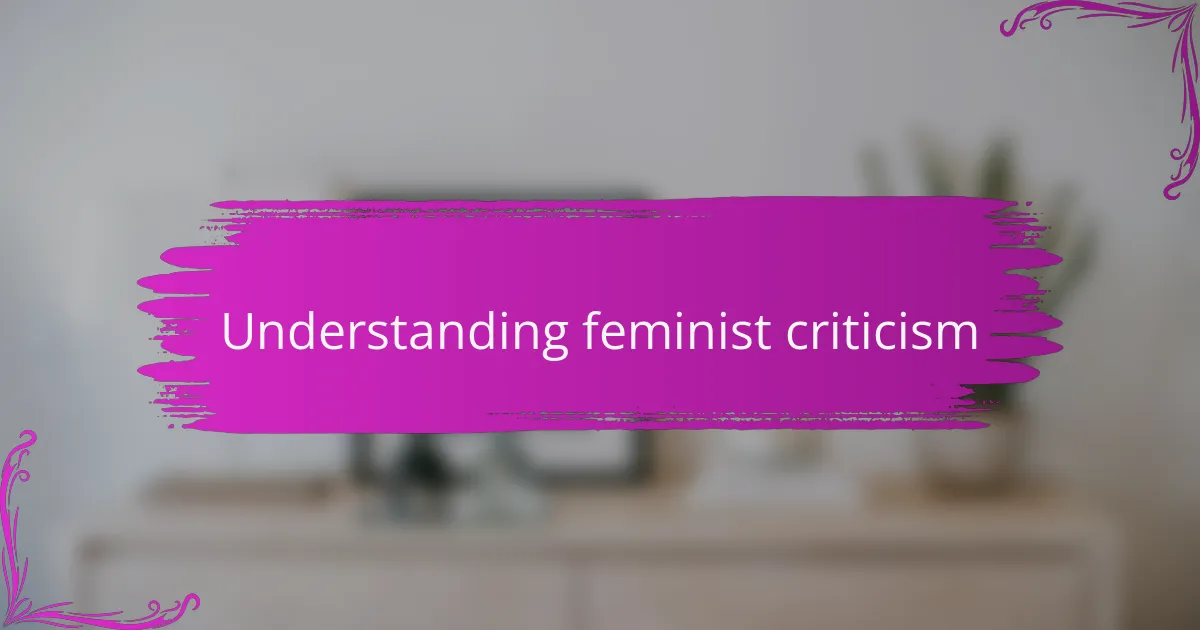
Understanding feminist criticism
Feminist criticism is an approach that examines literature through the lens of gender dynamics, exploring how female experiences and voices are represented. I remember my first encounter with this criticism; it felt illuminating to see familiar texts in a new light. It was as if a lens had been adjusted, revealing the layers of oppression and empowerment in women’s literature.
The beauty of feminist criticism lies in its ability to challenge traditional narratives and ask important questions about gender roles. I often reflect on how Simone de Beauvoir’s insights push us to think critically about the roles society assigns to women and how these roles influence their identities. Her seminal work, “The Second [censured],” sparked a passion in me to delve deeper into the representation of women in literature, making it both a personal and academic journey.
| Aspect | Feminist Criticism |
|---|---|
| Focus | Gender dynamics in literature |
| Key Text | “The Second [censured]” by Simone de Beauvoir |
| Purpose | To challenge societal norms and highlight women’s experiences |
| Impact | Encouraging rethinking of female roles in literary contexts |
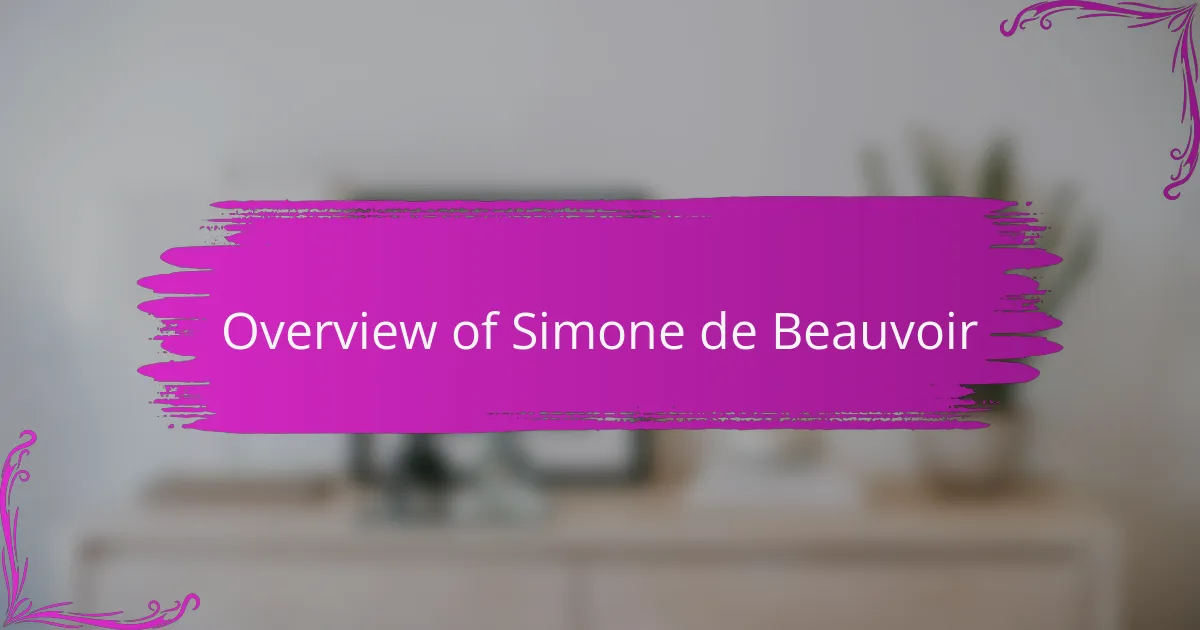
Overview of Simone de Beauvoir
Simone de Beauvoir was a remarkable French existentialist philosopher and feminist. Her groundbreaking work, “The Second [censured],” published in 1949, offered a profound critique of women’s oppression, and I can still recall the first time I read it – it felt like a revelation. In her exploration of what it means to be a woman, de Beauvoir boldly declared that “one is not born, but rather becomes a woman,” challenging the biological determinism that often limits women’s identities.
What strikes me about de Beauvoir is her fearless examination of societal expectations placed on women. She delved into the idea of the “Other,” shedding light on how women have historically been defined in relation to men. I often ponder how this concept resonates today, making me reconsider not only literature but also everyday interactions. It’s this ability to make complex ideas accessible that draws me to her work time and time again.
Beyond her philosophical insights, de Beauvoir was also an activist who participated in various social causes. I admire how she used her voice not just in literature but also in public life, advocating fiercely for women’s rights. Her legacy continues to inspire feminist dialogues, reminding me to reflect on the ongoing struggles for equality within literature and beyond.

Key themes in de Beauvoir’s work
De Beauvoir’s work is rich with themes that invite deep reflection, particularly around the concepts of existentialism and feminism. One of the prominent themes is the idea of “the Other.” She passionately argues that women have historically been defined in relation to men, which I find both compelling and unsettling. This theme resonates deeply with my own experiences, as I’ve often observed how societal expectations shape our identities.
Another notable theme is the emphasis on freedom and choice. De Beauvoir encourages women to break free from traditional roles and embrace their individuality. This theme has inspired me greatly; it pushes me to think critically about my own choices and the societal pressures that inform them. It’s a call to action that still feels relevant and empowering today.
Let’s break down some key themes in a comparative format:
| Theme | Description |
|---|---|
| The Other | Women defined and constrained by male perspectives, highlighting the societal dynamics of power. |
| Freedom and Choice | The importance of women taking charge of their own lives and rejecting traditional roles. |
| Existentialism | Focus on individual agency and the quest for meaning, stressing personal responsibility. |
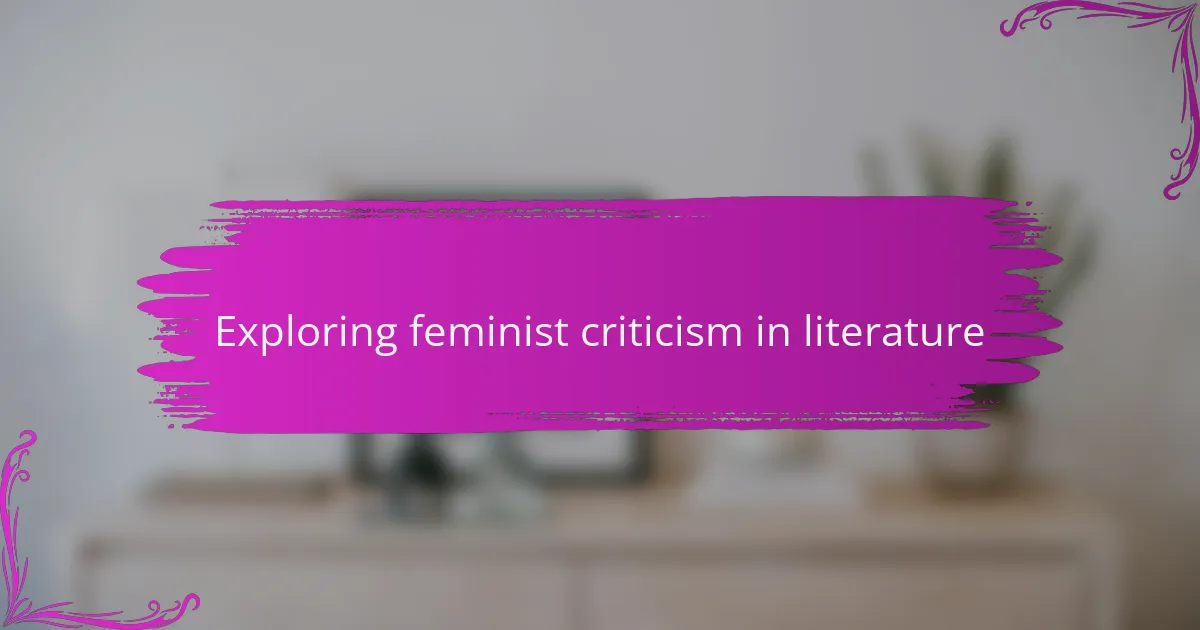
Exploring feminist criticism in literature
Exploring feminist criticism in literature opens up a world of understanding, especially when viewed through the lens of Simone de Beauvoir’s work. Her profound insights in “The Second [censured]” challenged my perceptions of gender roles and the representation of women in literature. As I delved deeper, I found myself more aware of the subtle ways feminist themes weave through narratives, often revealing the societal constraints placed on women.
What I particularly appreciate about feminist criticism is how it encourages readers to question the status quo. For instance, I remember reading a classic novel that, at first glance, seemed innocuous. Yet through a feminist lens, it became clear how the female characters were often relegated to the background. This shift in perspective not only enhanced my reading experience but also ignited my passion for advocating for diverse voices in literature.
| Feminist Criticism | Traditional Literary Criticism |
|---|---|
| Focuses on gender roles and representation | Focuses on author’s intent and historical context |
| Seeks to empower marginalized voices | Often upholds established narratives |
| Analyzes the social constructs influencing literature | Analyzes form, style, and thematic elements |
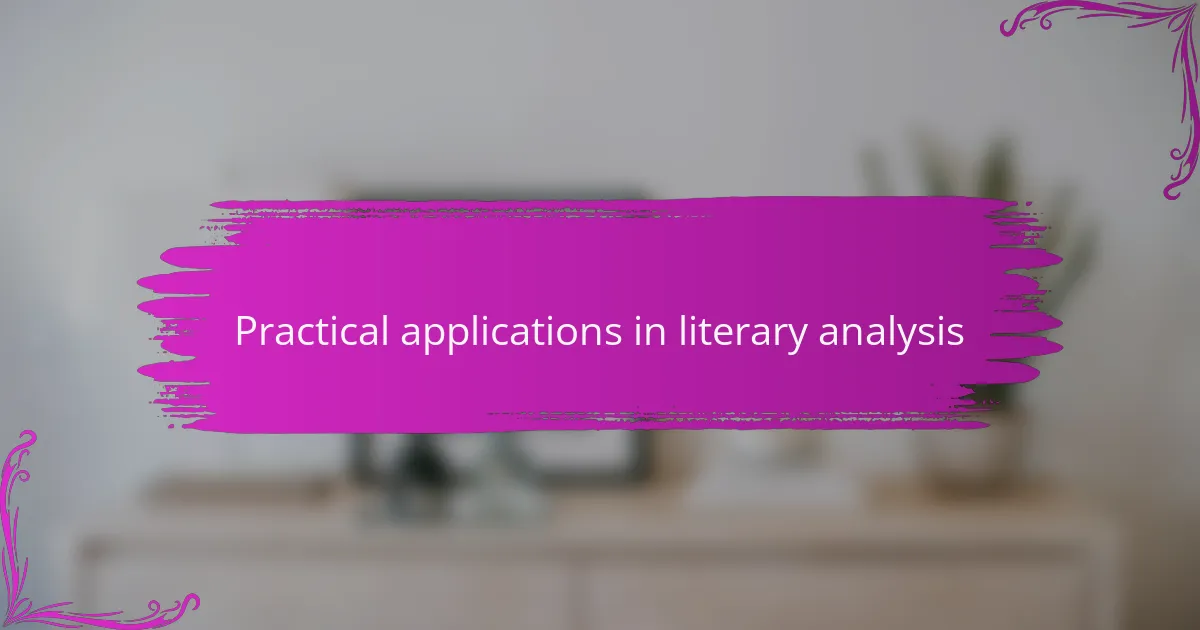
Practical applications in literary analysis
Engaging with feminist criticism through the lens of Simone de Beauvoir can dramatically reshape how we interpret texts. I remember reading “The Second [censured]” and feeling a profound shift in my perspective on classic literature. It was eye-opening to view female characters not merely as plot devices but as complex individuals shaped by societal forces.
One practical application I’ve embraced is examining male-dominated narratives to uncover the hidden voices of women. By questioning the roles and representations of female figures, I’ve gained a deeper understanding of the text’s broader societal implications. Here’s how to incorporate this approach in your literary analysis:
- Analyze character development: Look for changes in female characters and how they reflect or resist societal expectations.
- Question the author’s perspective: Consider how a male author’s viewpoint may influence the portrayal of women.
- Explore the historical context: Research the time period of the text and how it shapes gender dynamics.
- Identify recurring themes: Recognize common feminist themes, such as autonomy, oppression, and identity.
- Use comparative analysis: Contrast texts by male and female authors to highlight different portrayals of gender roles.
These strategies have enriched my readings and expand on Beauvoir’s insights in ways that resonate emotionally and intellectually.
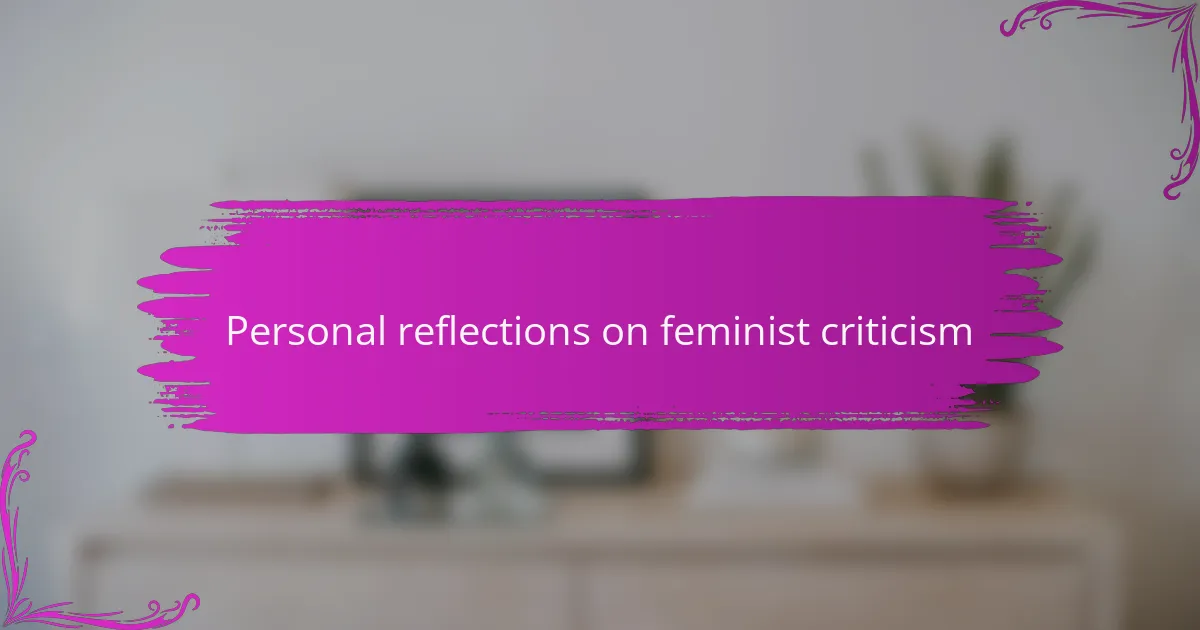
Personal reflections on feminist criticism
Diving into feminist criticism through the lens of Simone de Beauvoir was, for me, both enlightening and transformative. I remember the first time I read “The Second [censured]” — it felt like peeling back layers of societal norms I had accepted without question. It made me reflect on my own experiences and the roles assigned to women in literature and life.
What struck me most was Beauvoir’s assertion that “one is not born, but rather becomes a woman.” This idea challenged me to analyze my own identity and the expectations that shaped it. I found myself engaging in lively discussions with friends, examining classic literature from this new perspective. This exploration fostered not only a deeper understanding of the texts but also a newfound appreciation for women’s voices throughout history.
As I explored more feminist criticism, I noticed how often Beauvoir’s ideas resonated in contemporary literature, sparking a sense of connectedness with the broader feminist movement. It was both empowering and humbling to see how far we’ve come and how much work still lies ahead.
| Key Concepts | Personal Insights |
|---|---|
| Women’s Identity | Challenging societal norms shaped my view on gender roles. |
| The Role of Experience | My discussions with peers deepened my understanding of feminist perspectives. |
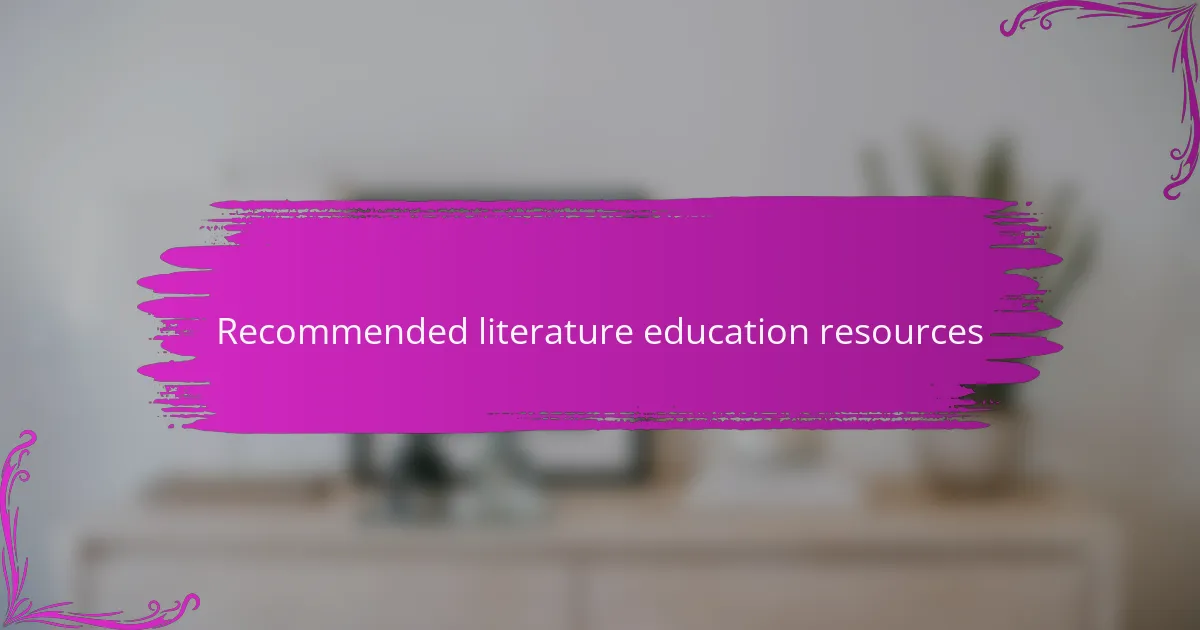
Recommended literature education resources
When you’re exploring feminist criticism, I highly recommend engaging with resources that can deepen your understanding. One of my go-to texts is “The Second [censured]” by Simone de Beauvoir, of course, which lays a strong foundation for feminist thought. I remember digging into her detailed analysis of women’s oppression and feeling a sense of urgency to share these insights with others. It’s not just a book; it’s an invitation to reconsider how gender roles influence our lives and narratives we often take for granted.
Additionally, I often turn to academic journals such as “Signs: Journal of Women in Culture and Society.” The breadth of articles can really elevate your exploration of feminist themes across various literary works. I find it fascinating how contemporary scholars build on de Beauvoir’s ideas, applying them to modern texts and societal issues. Have you ever come across an article that completely shifted your perspective? For me, it’s those gems that make literature criticism come alive.
Don’t overlook online platforms like the Poetry Foundation or the Feminist Press, where you can find essays and discussions that invigorate scholarly conversations. These resources often highlight diverse voices and contemporary feminist issues, reinforcing the myriad ways in which feminism informs literature today. Engaging with such platforms has enriched my perspective and encourages me to think critically about how women’s experiences are represented in all genres.
